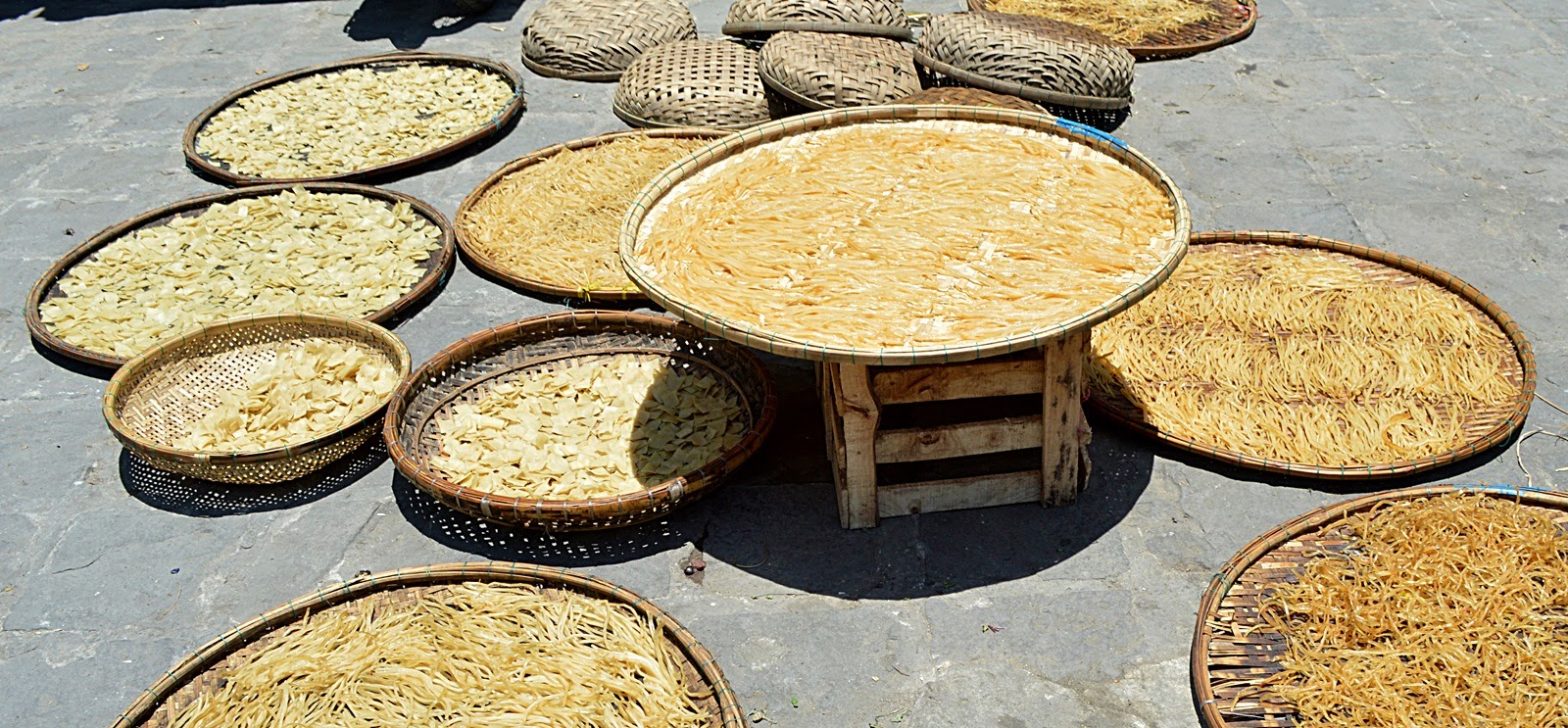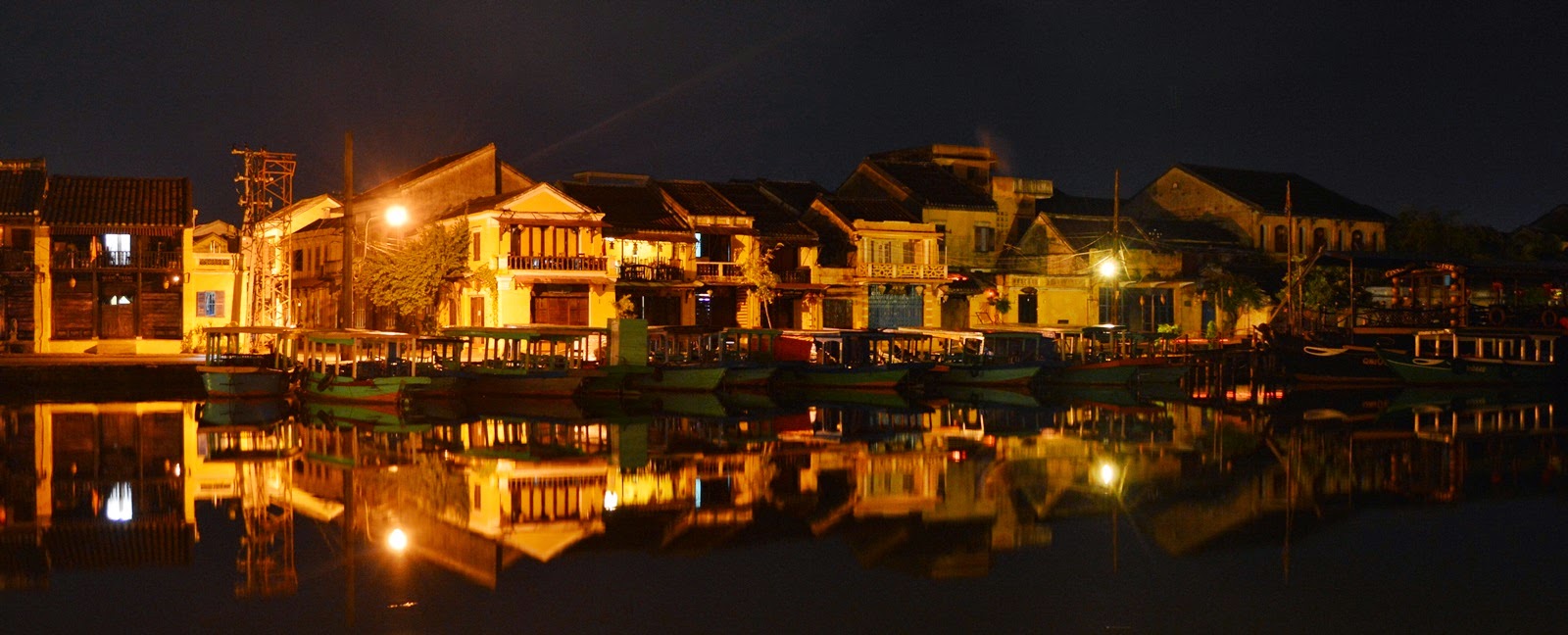De nuevo bus cama nocturno y de nuevo una destinación, esta vez la elegida era HÔI AN, situada en la costa del Mar de la China Meridionial y que allá por el siglo I era el puerto mas importante del sureste asiático,conocida como Lam Ap Pho.
Ademas durante los siglos XVI y XVII fue sin duda uno de los puntos comerciales por excelencia, aquí se asentaron chinos, indios, japoneses , holandeses y franceses.Y es gracias a este amalgama de culturas que la actual Hôi An sigue teniendo un encanto particular, pues la herencia de cada pueblo que aquí se asentó sigue impregnando la ciudad, en lo cultural y en lo arquitectónico.
Hôi An tenía el encanto de dejarte perder en la zona vieja de la ciudad, esa parte donde conviven edificios coloniales franceses, con edificios y templos de origen chino y japones. La joya de la ciudad es su famoso puente japones, cubierto y enlazado a una pagoda budista.También uno pude recorrer varios edificios antiguos de origen chino, donde aún hoy viven las nuevas generaciones de aquellos que se asentaron siglos atrás.
El entorno de la parte vieja, es un lugar tranquilo, hermoso y sosegado, donde las tiendas de recuerdos, las sastrerías y la tradición conviven entre turistas y locales dedicados a sus quehaceres y negocios.
Si perderse por el día es gratificante, perderse por la noche es abrumador. Allí entre el juego de colores de cientos de farolillos colgados por todos los rincones y la rivera del río Thu Bon, uno encuentra un remanso de paz, un momento de placer único. Y entonces solo queda pasear y contemplar todo aquello que esta histórica ciudad esta dispuesta enseñarte.
Pero Hôi An, escondía aún mas cosas, ¡sus increíbles playas!. No pudimos resistirnos a ir a descubrir la playa de Cua Dai, una auténtica maravilla con kilómetros de arena blanca, aguas cristalinas y pescadores en plena faena, además claro está, de diversos turistas y locales disfrutando de la mar y de las tumbonas.
Hôi An por tanto quedará grabada en mi memoria, por su importancia histórica y por su calmada belleza.
Hoi An is an ancient trading port from the period between 15th-19th century. It is very well preserved and is a great example of the influences of the different cultures that had their meeting piont in this little harbour. The most visible influence is this of China and Japan, but also the european and indigenous motifs are clear to find. There are several types of buildings that can be visited- pagodas, wooden japanese bridge or old chinese merchant houses still inhabited by new generations of the same families.
The old town still has it's original street plan of a typical South-East Asian trading port. The market, placed close to the river is still full of vendors and very busy, but the central spot of the town are now the alleys along the Thu Bon River. During the day you can enjoy the views over the boats taking strolls on the river, while eating your lunch. In the evening the alleys on both river banks turn very romantic, with all the lanterns reflecting in the water. But off course, there are also some fine places to party and a small night market with many cheap dinner options.
For me Hoi An will always be the city of lanterns. It is surely beautiful during the day, but at nighttime it turns into a real magic full of colorfull lights.
And- if you had enough of city tourism, Hoi An also offers you a beach. We chose the less urbanised Cua Dai and had a blast there- it was perfect for a lazy afternoon.
Szorcik: Hoi An to dawny port kupiecki, słynny na całą Azję południowo- wschodnią. Miasto zachowało się do dziś bardzo dobrze. Nadal widoczny jest plan zabudowy, typowy dla portowych azjatyckich miasteczek: główne ulice położone są równolegle do rzeki i połączone ze sobą mniejszymi, prostopadłymi. Domy wybudowane nad rzeką posiadały tylne wyjścia prowadzące w stronę rzeki, co ułatwiało wyładunek towarów, natomiast front domów, ze sklepami znajdował się od strony ulicy równoległej do portu.
W architekturze widoczne są nadal wpływy wszystkich kultur i regionów z których pochodzili kupy. Przeważają motywy chińskie i japońskie z dużą domieszką późniejszych-europejskich. Oprócz budynków mieszkalnych sporo tu zabudowań sakralnych, nawet na japońskim moście znajduje się niewielka pagoda. W kupieckich domach otwartych do zwiedzania nadal mieszkają te same same rodziny, co kilka generacji temu i to właśnie ich członkowie oprowadzają po wykończonych drewnem domach-muzeach.
Targowisko położone nad rzeką nadal tętni życiem, ale turyści zdają się preferować spacery wzdłuż rzeki, gdzie w ciągu dnia można zjeść obiad w restauracji w kolonialnym stylu, podziwiając przepływające łódki wiozące turystów na przejażdżkę wzdłuż portu. W nocy wody rzeki odbijają tysiące świateł i światełek kolorowych chińskich lampionów a pod mostem przepływają świeczki zapalone na szczęście. Dla tych, którym ta wizja wydaje się nazbyt romantyczna, są również inne opcje- jak darmowa fajka wodna w barach nad rzeką lub nocne targowisko pełne bibelotów oraz stoisk z tanim jedzeniem.
Ale dla mnie Hoi An to i tak najbardziej klimatyczne miasteczko- w dzień idealne do spacerów wśród pięknie zachowanych budynków, a w nocy wybuchające niczym fajerwerki tysiącem kolorowych chińskich lampionów.
A jak miejska turystyk się znudzi. można skoczyć na pobliską plażę... my wybraliśmy mniej popularną i niezabudowaną Cua Dai- był to strzał w dziesiątkę i cudowne, słoneczne popołudnie.
Ademas durante los siglos XVI y XVII fue sin duda uno de los puntos comerciales por excelencia, aquí se asentaron chinos, indios, japoneses , holandeses y franceses.Y es gracias a este amalgama de culturas que la actual Hôi An sigue teniendo un encanto particular, pues la herencia de cada pueblo que aquí se asentó sigue impregnando la ciudad, en lo cultural y en lo arquitectónico.
Hôi An tenía el encanto de dejarte perder en la zona vieja de la ciudad, esa parte donde conviven edificios coloniales franceses, con edificios y templos de origen chino y japones. La joya de la ciudad es su famoso puente japones, cubierto y enlazado a una pagoda budista.También uno pude recorrer varios edificios antiguos de origen chino, donde aún hoy viven las nuevas generaciones de aquellos que se asentaron siglos atrás.
El entorno de la parte vieja, es un lugar tranquilo, hermoso y sosegado, donde las tiendas de recuerdos, las sastrerías y la tradición conviven entre turistas y locales dedicados a sus quehaceres y negocios.
Si perderse por el día es gratificante, perderse por la noche es abrumador. Allí entre el juego de colores de cientos de farolillos colgados por todos los rincones y la rivera del río Thu Bon, uno encuentra un remanso de paz, un momento de placer único. Y entonces solo queda pasear y contemplar todo aquello que esta histórica ciudad esta dispuesta enseñarte.
Pero Hôi An, escondía aún mas cosas, ¡sus increíbles playas!. No pudimos resistirnos a ir a descubrir la playa de Cua Dai, una auténtica maravilla con kilómetros de arena blanca, aguas cristalinas y pescadores en plena faena, además claro está, de diversos turistas y locales disfrutando de la mar y de las tumbonas.
Hôi An por tanto quedará grabada en mi memoria, por su importancia histórica y por su calmada belleza.
 |
| japanese bridge/ most japoński/ el puente japones. |
 |
| Hoi An is famous for it's artisanal noodles/ Hoi An znane jest z produkcji makaronów/ Hoi An es conocido por la producción de noodles. |
 |
| we met Axel & Camille (again:) ) |
Hoi An is an ancient trading port from the period between 15th-19th century. It is very well preserved and is a great example of the influences of the different cultures that had their meeting piont in this little harbour. The most visible influence is this of China and Japan, but also the european and indigenous motifs are clear to find. There are several types of buildings that can be visited- pagodas, wooden japanese bridge or old chinese merchant houses still inhabited by new generations of the same families.
The old town still has it's original street plan of a typical South-East Asian trading port. The market, placed close to the river is still full of vendors and very busy, but the central spot of the town are now the alleys along the Thu Bon River. During the day you can enjoy the views over the boats taking strolls on the river, while eating your lunch. In the evening the alleys on both river banks turn very romantic, with all the lanterns reflecting in the water. But off course, there are also some fine places to party and a small night market with many cheap dinner options.
For me Hoi An will always be the city of lanterns. It is surely beautiful during the day, but at nighttime it turns into a real magic full of colorfull lights.
And- if you had enough of city tourism, Hoi An also offers you a beach. We chose the less urbanised Cua Dai and had a blast there- it was perfect for a lazy afternoon.
Szorcik: Hoi An to dawny port kupiecki, słynny na całą Azję południowo- wschodnią. Miasto zachowało się do dziś bardzo dobrze. Nadal widoczny jest plan zabudowy, typowy dla portowych azjatyckich miasteczek: główne ulice położone są równolegle do rzeki i połączone ze sobą mniejszymi, prostopadłymi. Domy wybudowane nad rzeką posiadały tylne wyjścia prowadzące w stronę rzeki, co ułatwiało wyładunek towarów, natomiast front domów, ze sklepami znajdował się od strony ulicy równoległej do portu.
W architekturze widoczne są nadal wpływy wszystkich kultur i regionów z których pochodzili kupy. Przeważają motywy chińskie i japońskie z dużą domieszką późniejszych-europejskich. Oprócz budynków mieszkalnych sporo tu zabudowań sakralnych, nawet na japońskim moście znajduje się niewielka pagoda. W kupieckich domach otwartych do zwiedzania nadal mieszkają te same same rodziny, co kilka generacji temu i to właśnie ich członkowie oprowadzają po wykończonych drewnem domach-muzeach.
Targowisko położone nad rzeką nadal tętni życiem, ale turyści zdają się preferować spacery wzdłuż rzeki, gdzie w ciągu dnia można zjeść obiad w restauracji w kolonialnym stylu, podziwiając przepływające łódki wiozące turystów na przejażdżkę wzdłuż portu. W nocy wody rzeki odbijają tysiące świateł i światełek kolorowych chińskich lampionów a pod mostem przepływają świeczki zapalone na szczęście. Dla tych, którym ta wizja wydaje się nazbyt romantyczna, są również inne opcje- jak darmowa fajka wodna w barach nad rzeką lub nocne targowisko pełne bibelotów oraz stoisk z tanim jedzeniem.
Ale dla mnie Hoi An to i tak najbardziej klimatyczne miasteczko- w dzień idealne do spacerów wśród pięknie zachowanych budynków, a w nocy wybuchające niczym fajerwerki tysiącem kolorowych chińskich lampionów.
A jak miejska turystyk się znudzi. można skoczyć na pobliską plażę... my wybraliśmy mniej popularną i niezabudowaną Cua Dai- był to strzał w dziesiątkę i cudowne, słoneczne popołudnie.


































No hay comentarios:
Publicar un comentario